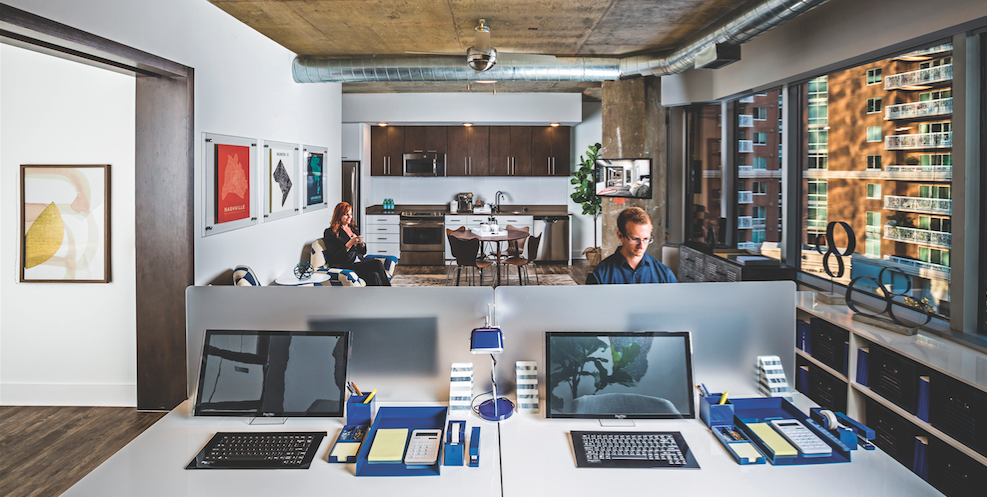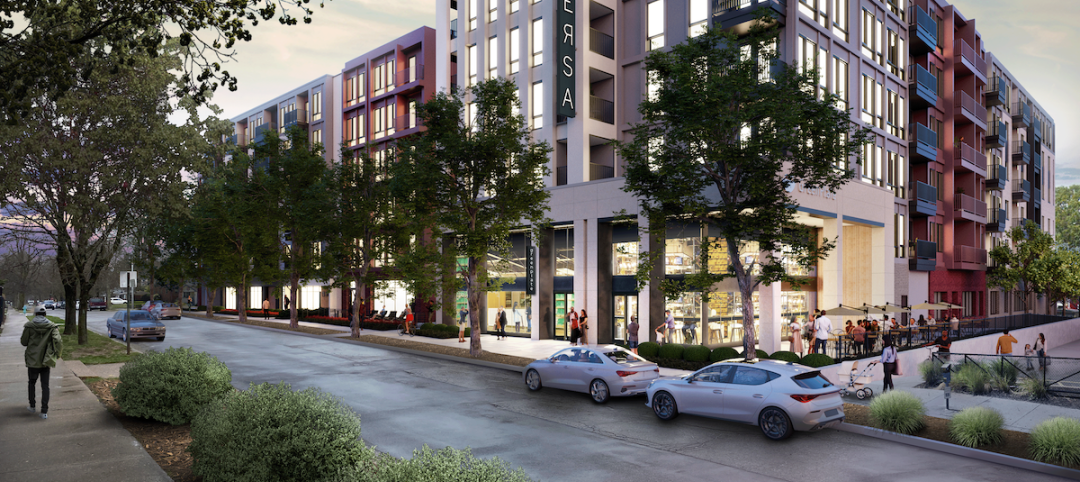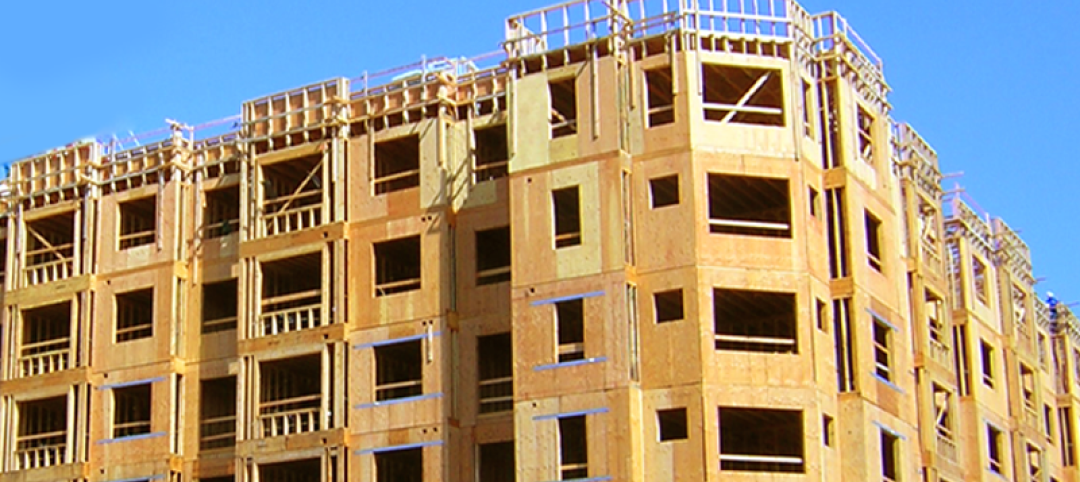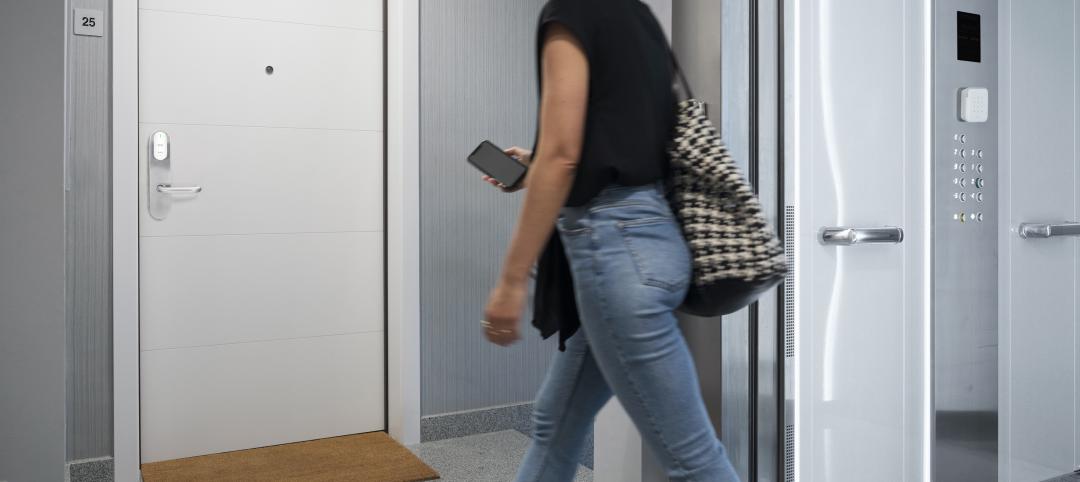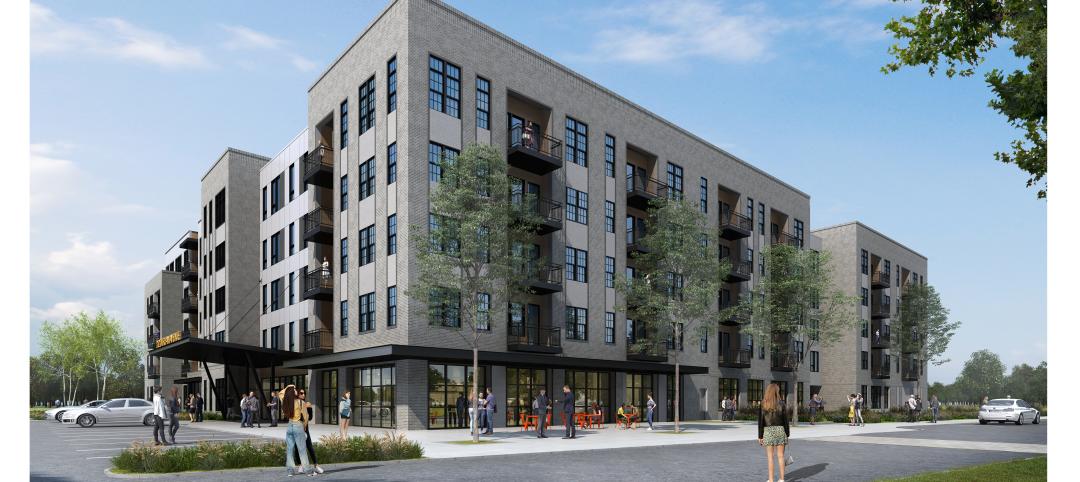The new e-lofts, a 200-unit complex now leasing in Alexandria, Va., owes its genesis to the smartphone. Thanks to our smartphones (and laptops and tablets) we no longer have to be tethered to our cubicles. We can work from practically anywhere. The Census Bureau says 6.8 million Americans—4.6% of the U.S. workforce—work from home. Global Workplace Analytics estimates that 20–25% of U.S. workers do so remotely part time.
The practical effect of the unshackling of the American worker is that traditional downtown and suburban office buildings are bleeding tenants. In Northern Virginia, which includes the city of Alexandria, there are about 150 office buildings with vacancies of 50,000 sf or more, according to the Washington Post. Office rentals in the metro area are flat, even as the region added 66,600 jobs last year.
About three years ago, Conrad Cafritz, Chairman/CEO of Cafritz Interests and the son of legendary Washington, D.C., real estate developer Morris Cafritz, pondered this disturbing scenario. His five decades’ experience in real estate told him that most of these structures were beyond salvation as office properties. Yet most of them were basically good buildings. They were usually in choice locations. They had been the trophy properties in their markets when they first opened their doors. Most had tons of parking, and they usually had “good bones,” structurally speaking. But time and technology had rendered them obsolete.
With all those plusses, Cafritz wondered, why couldn’t these properties be put to better use?
At some enlightened moment in his reverie, Cafritz hit upon a revolutionary idea. Most local jurisdictions in the D.C. area, he knew, permitted mixed-use buildings—office, retail, residential, even hotel—in certain zoning districts, as long as the respective uses were physically separated from one another.
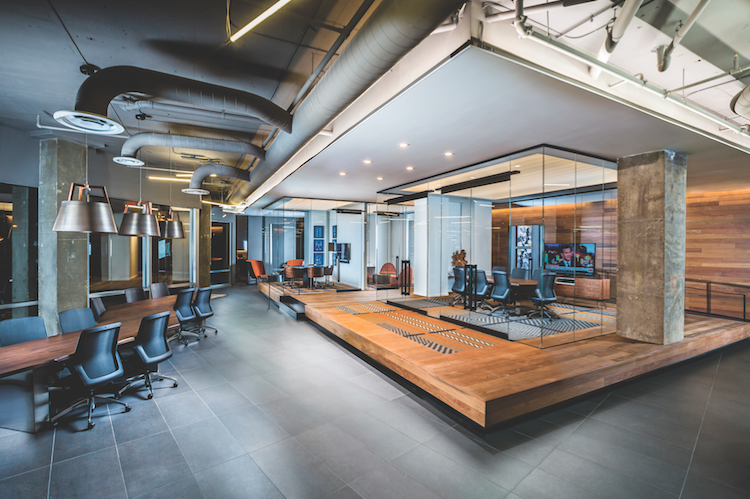 An elevated glassed-in conference room (280 sf, expandable to 410 sf) can be curtained for privacy. “The wood [ipe] brings in a warmer feeling,” says Gensler’s Joanna Shin. “We wanted to avoid a gritty-grungy startup feel, to balance high-end residential with commercial-corporate.” Area at left has workstations with undercounter power/data ports. Flooring: Basaltina stone tile
An elevated glassed-in conference room (280 sf, expandable to 410 sf) can be curtained for privacy. “The wood [ipe] brings in a warmer feeling,” says Gensler’s Joanna Shin. “We wanted to avoid a gritty-grungy startup feel, to balance high-end residential with commercial-corporate.” Area at left has workstations with undercounter power/data ports. Flooring: Basaltina stone tile
What if these old relics could be renovated to allow for three different kinds of uses—Cafritz called them “live,” “live-work,” and “work”? And not just in the same building but—and this was the genius stroke—on the same floor? That could be a game changer. Hundreds of vacant or distressed office buildings could be converted into properties that offered the lessee a choice of three options. Cafritz was well aware that no one in the Washington real estate market—maybe not in the whole country—had ever tried it, but that wasn’t going to stop him.
In 2015, he and Robert M. Seldin, CEO of Novus Residences, a multifamily partnership within Cafritz Interests, purchased a vacant 14-story office building near I-395 in Alexandria. The property, built in 1987, was assessed at $57.4 million; they got it for $20 million. They brought in Lord Aeck Sargent (architect), Gensler (interiors/visioning), and Landworks Studio (landscape design) to turn Cafritz’s vision into reality. Then they marched off to City Hall to plead their case to the local authorities.
REINTERPRETING THE ZONING
The newly acquired property was zoned for high-density mixed use. Both commercial office and multifamily residential were allowed, but only “in a single structure or multiple but integrated and related structures.” In other words, offices and living spaces had to be physically separated from each other.
The developer appealed to the city for a broader interpretation of the ordinance. Novus wanted to meet the needs of three target groups: couples who wanted lots of living space; work-at-home singles and couples; and small businesses of 10 employees or less, which, as Seldin told city officials, make up three-fourths of U.S. companies. Would the city allow a mix of these three uses on the same floor?
Robert Kerns, AICP, Alexandria’s Development Division Chief, says the city was intrigued with the idea, but had to tread carefully. “We’re both a regulatory agency and one that encourages economic investment in the city,” he says. But city officials had good reason to be open-minded. Alexandria already had “a lot of underutilized or vacant space,” says Kerns. The Novus concept might just be a way to turn some of those empty boxes into sorely needed housing and space for emerging businesses.
Negotiations went on (amicably, according to all parties) for several months.
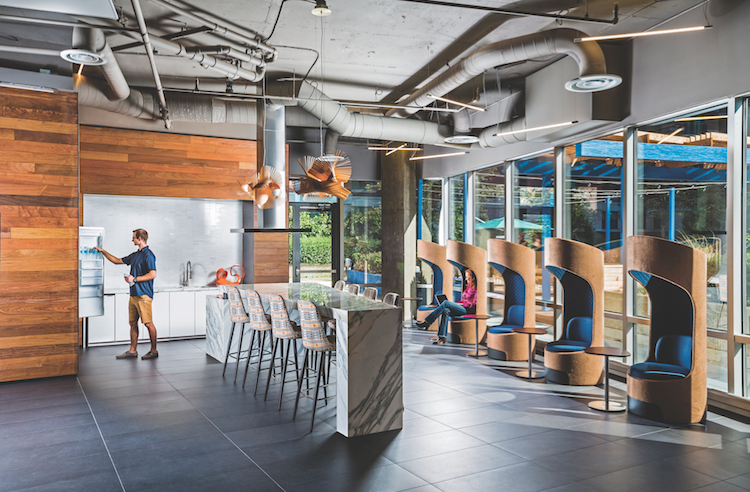 The fully equipped demonstration kitchen can host corporate events, celebrity chef demonstrations, or casual parties. The back door leads to the outdoor patio/grill area. The “lipstick chairs” (right) provide “cones of silence” for individual users. The design team skewed the grid to achieve spatial variety and visual interest.
The fully equipped demonstration kitchen can host corporate events, celebrity chef demonstrations, or casual parties. The back door leads to the outdoor patio/grill area. The “lipstick chairs” (right) provide “cones of silence” for individual users. The design team skewed the grid to achieve spatial variety and visual interest.
The city took the position that it was open to a reasonable interpretation of the “commercial/residential” language of the ordinance, provided all other zoning requirements—particularly as to parking and open space—were met. With 541 slots, the property more than complied with the parking requirements (five spaces per 1,000 sf of area). Counting the 30,000-sf deck roof on the parking structure as open space (OK under the ordinance), the property easily met the 40% open-space minimum.
“It was a new idea, and the city prides itself on being in the forefront of development trends,” says Kerns. “We felt they were meeting the zoning impacts.” But the decision would not reflect blanket city policy. It applied only to the e-lofts application, says Kerns. But as long as Novus strictly complied with the building code, no zoning variances would be required.
In the fall of 2015, the general contractor, Paradigm Contractors, was given the go-ahead to start demolition. E-lofts was on its way.
A SOLID BUILDING TO WORK WITH
The basic structure of the building had a lot going for it. “We wanted to take advantage of the 10-foot floor-to-ceiling heights and the expanse of the windows,” says Warren L. Williams, AIA, Principal, Lord Aeck Sargent. Ceilings and ductwork were purposely exposed for a high-tech effect. “We didn’t want to clutter things up,” he says.
The IT infrastructure that electrical subcontractor Cherry Lane provided is “very robust,” says Williams. There’s fiber optic service to every space, and easy access to power and data ports. Tenants can pipe right to their wiring closet and use it as a server room. “It’s a fat backbone,” says Williams. “They can use their own local area network or Novus’s.”
The 176 one-bed, one-bath loft units and 24 two-bed, two-bath lofts have 10-foot exposed ceilings, movable pocket walls, full-size washer/dryers, walk-in showers, soaking tubs, and Euro-style kitchens with pantries, quartz countertops, and bottom-drawer freezers.
The team did experience the occasional hiccup. “We had to go back a few times to the code officials to explain the concept behind mixing these spaces for both residential and commercial use,” says Joanna Shin, AIA, LEED AP, SEED, an Associate with Gensler. Because the huge windows were not operable, they had to pump up the fresh-air intake. Mechanical/plumbing contractor Hurst Engineers had to do a considerable amount of bath and kitchen work to make the original office spaces suitable for residences.
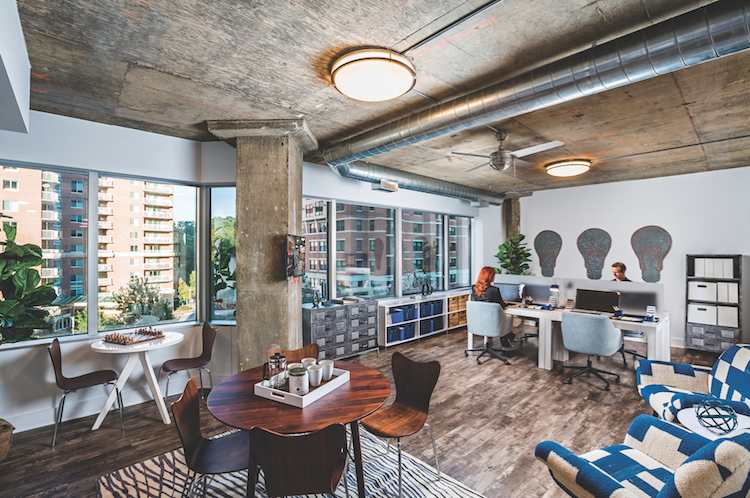 The loft-style one- and two-bedroom “live” or “live-work” units have 10-foot exposed ceilings, movable pocket walls, full-size washers and dryers, walk-in showers and soaking tubs, and Euro-style kitchens with pantries, quartz countertops, and bottom-drawer freezers. The “work” units have similar amenities, although the bedrooms are fitted for office use. Monthly rents run from $1,565 to $2,800 for one-bedrooms; two-bedrooms run $2,950/month.
The loft-style one- and two-bedroom “live” or “live-work” units have 10-foot exposed ceilings, movable pocket walls, full-size washers and dryers, walk-in showers and soaking tubs, and Euro-style kitchens with pantries, quartz countertops, and bottom-drawer freezers. The “work” units have similar amenities, although the bedrooms are fitted for office use. Monthly rents run from $1,565 to $2,800 for one-bedrooms; two-bedrooms run $2,950/month.
One place where they didn’t spend a lot of time or money: the façade. “The client wanted to put the emphasis on the interior,” says Shin.
On the exterior, the 30,000-sf parking garage roof gave Landworks Studio a chance to create a “cohesive experience, a living environment,” says Director of Design Mike Blier, ASLA, RLA, Hon. BSA. “It’s a kind of backyard, where we’ve programmed a range of amenities that everyone from individuals or couples up to large groups can enjoy.”
There’s a patio-with-pergola that leads to the indoor kitchen, a “beach” for lounging and sunbathing, and flex space for active sports like badminton, table tennis, or volleyball. “We used simple, honest materials, nothing too fancy,” says Blier. Catenary lighting lends what he calls “an outdoor living-room effect” to the environment.
The city issued final certificates of occupancy in December, and Novus has been averaging 20 leases a month since, says Seldin. “They’re exceeding the amount of nonresidential tenants that we anticipated,” says Kerns. “They’re getting a mix of uses. People are embracing the concept.”
Cafritz and Seldin have plans to invest $250 million in repurposing vacant office buildings into e-lofts. They’ve already spread the e-lofts gospel to neighboring Fairfax County, where they’re retrofitting a vacant office building into 156 e-lofts.
It took less than six months to convince Fairfax officials to change the zoning ordinance to allow as much as 100% residential in Planned Development Commercial Districts, up from 50%. To clinch the verdict, Seldin took Fairfax’s elected officials on a tour of the Alexandria e-lofts. “They were impressed,” he says.
PROJECT TEAM | E-LOFTS
Client: Novus Residences, LLC Architect: Lord Aeck Sargent Interior design/Visioning: Gensler Corridor Design: Carlyn and Company Interiors + Design Landscape architecture: Landworks Studio Structural engineer: Ellinwood + Machado Civil engineer: VIKA Mechanical/plumbing: Hurst Engineers Electrical: Cherry Lane Life safety/Fire protection: Freedom Fire Protection General contractor: Paradigm Contractors, LLC
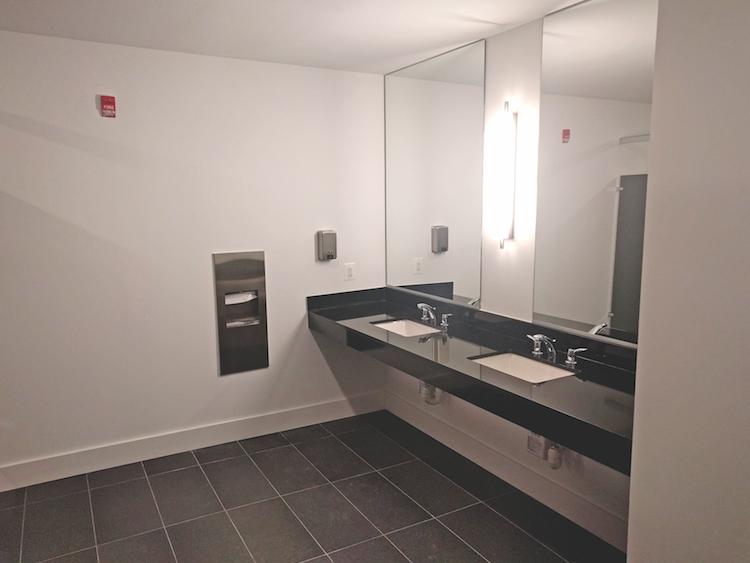 One amenity you won’t find in most apartment buildings: public toilets and water fountains in the hallways. The designers kept the originals to accommodate e-lofts businesses and their visitors. Courtesy Novus Residences
One amenity you won’t find in most apartment buildings: public toilets and water fountains in the hallways. The designers kept the originals to accommodate e-lofts businesses and their visitors. Courtesy Novus Residences
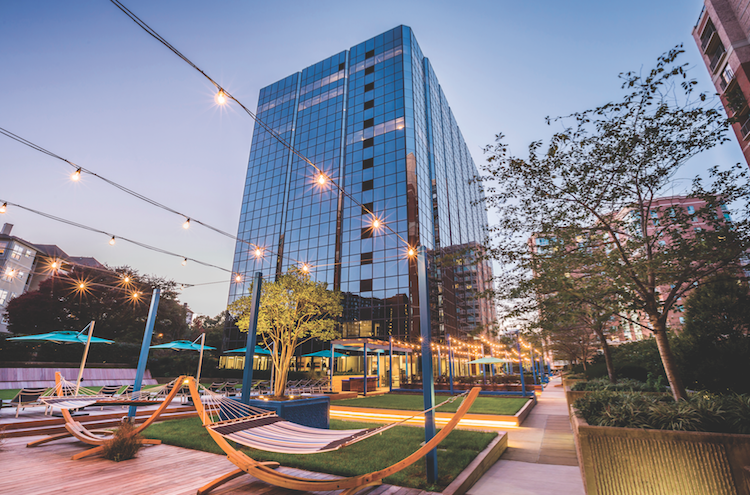 The 30,000-sf garage roof, with pergola-covered patio and outdoor dining area, can accommodate games, parties, and quiet leisure pursuits. Landworks Studio’s Mike Blier: “We used very simple materials—honest, nothing too fancy.” The deck helped meet Alexandria’s open space requirement.
The 30,000-sf garage roof, with pergola-covered patio and outdoor dining area, can accommodate games, parties, and quiet leisure pursuits. Landworks Studio’s Mike Blier: “We used very simple materials—honest, nothing too fancy.” The deck helped meet Alexandria’s open space requirement.
 The 2,000-sf club lounge is marked by formal wooden columns and soft furniture touches. Gensler’s Joanna Shin: “You can anchor yourself and work, have a lunch you’ve made in the nearby kitchen, or hold a small meeting.” Lord Aeck Sargent’s Warren Williams: “This is where visitors like to take selfies.”
The 2,000-sf club lounge is marked by formal wooden columns and soft furniture touches. Gensler’s Joanna Shin: “You can anchor yourself and work, have a lunch you’ve made in the nearby kitchen, or hold a small meeting.” Lord Aeck Sargent’s Warren Williams: “This is where visitors like to take selfies.”
Related Stories
Multifamily Housing | May 30, 2023
Milhaus, Gershman Partners, and Citimark close on $70 million multifamily development in Indy
Versa will bring 233 studio and one- and two-bedroom apartments to Indianapolis's $271 million, Class-A Broad Ripple Village development enterprise.
Multifamily Housing | May 23, 2023
One out of three office buildings in largest U.S. cities are suitable for residential conversion
Roughly one in three office buildings in the largest U.S. cities are well suited to be converted to multifamily residential properties, according to a study by global real estate firm Avison Young. Some 6,206 buildings across 10 U.S. cities present viable opportunities for conversion to residential use.
Multifamily Housing | May 19, 2023
Biden administration beefs up energy efficiency standards on new federally funded housing
The Biden Administration recently moved to require more stringent energy efficiency standards on federally funded housing projects. Developers building homes with taxpayer funds will have to construct to the International Energy Conservation Code (IECC) 2021 for low-density housing and American Society of Heating, Refrigerating and Air-Conditioning Engineers ASHRAE 90.1 for multi-family projects.
Sponsored | Multifamily Housing | May 19, 2023
Shear Wall Selection for Wood-Framed Buildings
From wall bracing to FTAO, there are many ways to secure the walls of a building. Learn how to evaluate which method is best for a project.
Sponsored | Multifamily Housing | May 17, 2023
The Key To Multifamily Access Control — Consistent Resident Experiences
Explore the challenges of multifamily access control and discover the key to consistent user experiences with a resident-first approach and open platforms.
Affordable Housing | May 17, 2023
Affordable housing advocates push for community-owned homes over investment properties
Panelists participating in a recent webinar hosted by the Urban Institute discussed various actions that could help alleviate the nation’s affordable housing crisis. Among the possible remedies: inclusionary zoning policies, various reforms to increase local affordable housing stock, and fees on new development to offset the impact on public infrastructure.
Multifamily Housing | May 16, 2023
Legislators aim to make office-to-housing conversions easier
Lawmakers around the country are looking for ways to spur conversions of office space to residential use.cSuch projects come with challenges such as inadequate plumbing, not enough exterior-facing windows, and footprints that don’t easily lend themselves to residential use. These conditions raise the cost for developers.
Multifamily Housing | May 12, 2023
An industrial ‘eyesore’ is getting new life as an apartment complex
The project, in Metuchen, N.J., includes significant improvements to a nearby wildlife preserve.
Senior Living Design | May 8, 2023
Seattle senior living community aims to be world’s first to achieve Living Building Challenge designation
Aegis Living Lake Union in Seattle is the world’s first assisted living community designed to meet the rigorous Living Building Challenge certification. Completed in 2022, the Ankrom Moisan-designed, 70,000 sf-building is fully electrified. All commercial dryers, domestic hot water, and kitchen equipment are powered by electricity in lieu of gas, which reduces the facility’s carbon footprint.


